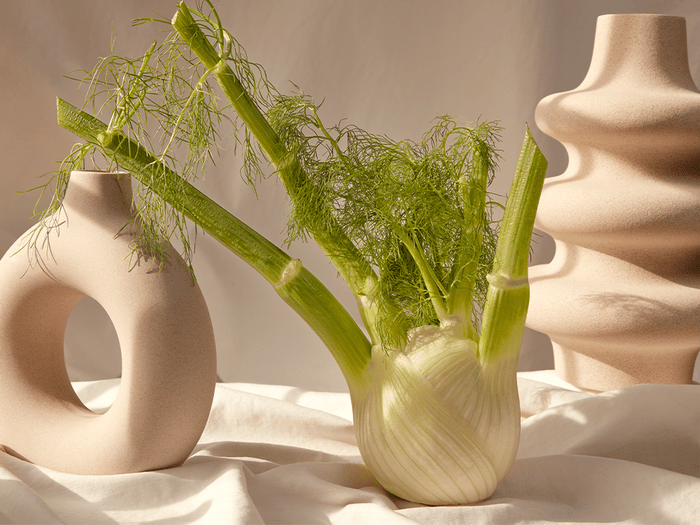Why You May Want to Add Fennel to Your Veggie Rotation

Fennel’s seeds, leaves and bulb are all packed with flavour and good-for-you compounds.
There are a few foods I didn’t discover until later in life. Fennel was one of those foods, but now it finds its way onto my grocery list every week. The celebrated vegetable is delicious both raw and roasted, and its dried seeds are equally versatile.
Fennel is a generous plant. Its leaves, seeds and bulb are packed with flavour and good-for-you compounds. There are two main types of fennel: Herb and Florence fennel. Herb fennel’s light green leaves resemble dill and sprout pale yellow flowers in the summer. Once these flowers turn brown, they’re harvested and hung to dry and the seeds that fall from the flowers are collected. These seeds are the final product that show up in the spice aisle at the grocery store.
Florence fennel, on the other hand, is what you’ll find in the produce section or at the farmer’s market, and can be eaten raw or cooked. It’s shorter with darker green foliage, called fronds, and celery-like stalks that extend down to a large white bulb, which forms the base of the plant. Both types of fennel have a mild anise flavour that is reminiscent of a sweeter black licorice.
Florence fennel is low in carbohydrates and is a good source of fibre, vitamin C, beta carotene (which our bodies turn into vitamin A) and potassium. Fennel seeds, meanwhile, are one of the world’s oldest medicinal herbs, and are used to create remedies for colds, allergies and stomach pain. Tinctures, teas and supplements are made from dried fennel seeds that are crushed to release their healthful essential oil. Anethole and fenchone, aromatic compounds that are major components of the essential oil, have been shown to break up and clear phlegm in the respiratory tract, making them an effective treatment for congestion. These compounds also relieve bloating and gas.
Anethole and fenchone are also known as phytoestrogens—plant chemicals that are similar in structure to estrogen and can mimic its action in the body. For post-menopausal people they can help manage symptoms that result from a shift in estrogen levels, like hot flashes and insomnia. In those who are still menstruating, anethole and fenchone have an anti-inflammatory effect that can relieve symptoms of premenstrual syndrome, like cramps and heavy bleeding, reducing the need for over-the-counter painkillers. In those who are breastfeeding, the compounds can stimulate prolactin secretion, the hormone responsible for milk production, although further studies are needed to confirm this.
Fennel seeds are also incorporated into spice blends across the Middle East and Asia, including Chinese five spice and garam masala. They’re used to flavour sausages, chutneys and marinara sauce. In many cases, fennel seed adds that hard-to-pinpoint flavour that makes a dish distinctive. Toasting and crushing the seeds activates their aroma, which lends itself well to curries, stews, salad dressings and roasted vegetables. They pair particularly well with tomatoes and roasted cauliflower. Fennel seeds are green when fresh and slowly turn a dull grey-brown as they age, so for the most flavour seek out green seeds.
When eaten raw, fennel bulbs are best thinly shaved and added to a salad or slaw—its strong flavour goes a long way. Shaved fennel makes a great addition to salads with a sweet element, like in a slaw with apples or a salad with citrus or beets. The bulb’s core and stalks are tougher and fibrous, so it’s best to leave them out of raw dishes, but they soften up nicely when cooked.
While raw fennel has a satisfying crunch, it becomes silky and tender when cooked and takes on a sweeter taste, which pairs beautifully with pork, fish and other seafood. Try thinly slicing and adding it to pizza with Italian sausage, arranging larger pieces under a chicken before roasting so it caramelizes and soaks up the tasty juices, or baking it into a cheesy, breadcrumb-topped gratin instead of using potatoes.
You can find fennel seeds year-round and Florence fennel is in season from fall through spring, making it the perfect veg when other produce like tomatoes and zucchini are not yet at their peak. If you’re suffering from veggie fatigue, add a fennel-spiked meal to your weekly rotation.
Laura Jeha is a registered dietitian, nutrition counsellor and recipe developer. Find out more at ahealthyappetite.ca.
Next: A Summer Soup? Yes—Just Try This Roasted Fennel and Tomato One




